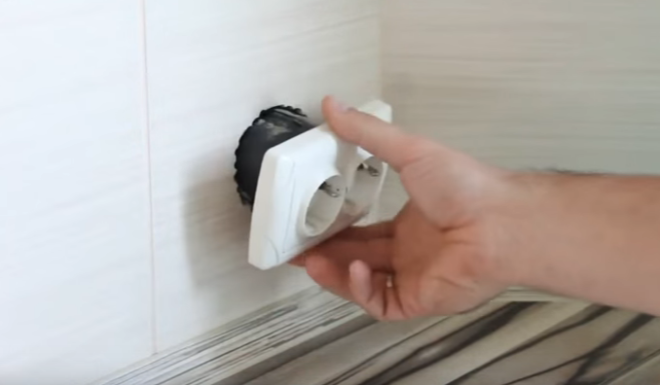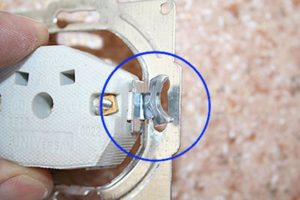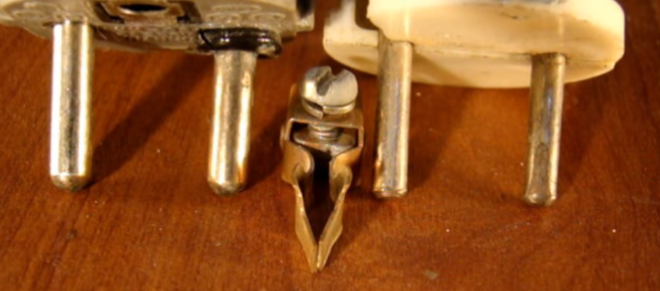How to fix an outlet if it falls out of the wall

If the installation of the outlet was done poorly, then over time it will simply begin to fall out of the wall following the plug that is pulled out of it. Before you fix the outlet again, you need to figure out why this happens at all, so as not to do the same work several times.
Content
What mistakes can be when installing sockets
To understand how to fix the drop-down outlet, you must first of all pay attention to whether it dangles by itself or together with the socket. These are two different malfunctions and each must be eliminated in its own way.
A correctly installed outlet is mounted according to a certain technology, and if one of the steps is done incorrectly or unsuitable materials are taken, then it may soon turn out that the work needs to be redone.
Errors can be at the following stages of installation:
- A hole is drilled in the wall, which should be slightly larger than the outer diameter of the socket box - so that putty or cement can be pushed between them. There are times when the socket box comes close to the wall and the impression was created that he sat there tightly. Then the final installation was carried out, but after a while the whole structure flew out of the wall, because all the clutch was held at several points.
- The inner surface of the hole is covered with putty and a socket is inserted into it. If there is little putty, it is not laid over the entire contact area, or a bad solution is simply prepared, then the mount will crumble.
- Installation of the insides of the socket. This design is held inside by sliding tendrils that are squeezed out by bolts. Accordingly, if the bolts are poorly tightened or the fasteners slide along the inner surface of the socket, then the entire outlet will soon begin to dangle and fall out.
- Installation of the outer, visible part of the socket. Most often, this stage of installation cannot in any way affect its loss in the future, but sometimes it happens that the inner part is not installed flush to the wall, but a little deeper. In this case, when tightening the fastening bolts, the inner part will move in the socket box or displace it itself.
An example of the correct installation of the socket outlets in this video:
And here we look at how to install the sockets in the socket:
When an internal socket falls out of the wall, the main reason is immediately visible - a falling out socket or poor engagement of the fastening antennae. In both cases, there are nuances that must be taken into account when troubleshooting.
If the wall socket does not hold
In this case, the repair method is chosen depending on what kind of socket is installed and from what the wall.
If the socket was not "planted" on the mortar, then the size of the hole in the wall is "back to back" and it needs to be slightly widened so that there is where to spread the mixture of gypsum or cement. Next, you need to inspect the socket itself - in modern models there are slots for threading the cable. They are located over the entire area, and if the putty is pressed through them a little, then this will be an additional fastening. If the socket is smooth, then you can make notches on its outer side, for which the solution will grab.
In extreme cases, if you do not have the necessary materials at hand, and it is desirable to fix the outlet urgently, you can simply screw the socket to the wall with screws. There is only one nuance here - drill holes for dowels from the corner and let them go obliquely so as not to loosen over time.
In some cases, you can try to attach the drop-down socket to liquid nails, as shown in the following video:
When there is no socket at all
Rarely, but it also happens - the socket dangles, and when you disassemble it, it turns out that it simply rests against the wall with spacer antennae, well if it is concrete.
There is only one correct solution to the problem - to install a socket box, as steel antennae will crumble even the most durable concrete over time and the socket will fall out.
If there is no other choice but to fix the socket in the wall (there is no socket and there is nowhere to buy it), then you can make a homemade socket mount. To do this, you will need to make chopiki: from dense linoleum, sandpaper or a couple of pieces of wooden board - preferably not overdried so as not to split when tightening the fastening bolts.
- It is necessary to try on where the spacer antennae rest against the wall and gently hollow out small recesses there.
- Chopiki are cut to the size of the resulting pits. If it is linoleum or sandpaper, then it is advisable to fold them in half, with the smooth side inward, so that the rough one touches the wall and the fastening antennae. The tree is simply given the desired shape - unlike the classic chopiks, which are made cylindrical, these must be made rectangular.
- Then the chopiki are inserted into the mountings, a socket is connected to them and the bolts are tightened, which expand the fastening antennae.
This method can be effective even for walls not made of the hardest material, such as adobe brick, but if possible, it is still recommended to make the correct fastening using socket outlets.
What to do if the outlet itself falls out
There may be two main reasons - insufficient squeezing of the fastening antennae and the smooth inner part of the socket, along which the fasteners simply slip.
In the first case, the fasteners simply do not reach the walls of the socket box or the pressing force is not enough to confidently hold the entire structure. This can be due to worn fasteners or mismatching models, when the outlet itself is smaller than the socket.

If the socket is still fixed in the socket, but then pulled out of it together with the plug, then it lacks quite a bit of pressing force. Here it will be enough just to slightly bend the fastening antennae - they resemble the letter "L" in shape, but with the upper part slightly bent up. If it is bent a little more, the downforce will increase. To do this, you need to unscrew the adjusting bolt, this part will fall out of the socket on its own and it can be corrected with pliers. Then everything can be installed in the reverse order. For a guaranteed result, in the place where the fastening antennae will abut, you can make several notches - with a knife or a soldering iron.
When the socket itself, even well fixed in the wall, is much larger than the outlet, then it is necessary either to change it completely or, again, to make chopiks and make notches on the inside.
Also, there are often cases when the surface of the socket at the point of contact with the spacer antennae is simply lapped. An effective solution is to remove the socket and then install it, but at an angle of 90 ° from the original position. It is even easier to rotate the socket itself - double and triple are often installed this way - in a horizontal position.
Before deciding what to do if the outlet falls out of the socket, you need to inspect the case of the latter - in modern models there are fastening bolts with which the socket is simply screwed to their case.
Differences between old and new sockets

Wall-mounted switches are attached in the same way, but they fall out much less often.The reason is simple - when switching on and off, the force is always applied in the direction of the wall. In sockets, everything is different - when the plug is inserted into them, then the force is directed towards the wall, and when it is removed, then back.
In older sockets, this problem was not so acute, because they were designed for devices with much lower power consumption. This automatically meant that there were no strict requirements for the force of pressing the contacts - the plugs were inserted and removed from the sockets with much less effort - since that time, many users have become a habit of pulling the plug by the cord. It is forbidden to remove the plug in this way now and was not allowed before, but with the old outlets there was enough safety margin, so often such requirements were simply not paid attention to.
In modern sockets, spring-loaded contacts are used, which are very tightly pressed against the live parts of the plugs. Even the socket installed according to all the rules will gradually loosen, therefore it is recommended in any case to hold it with your hand when removing the plug.




